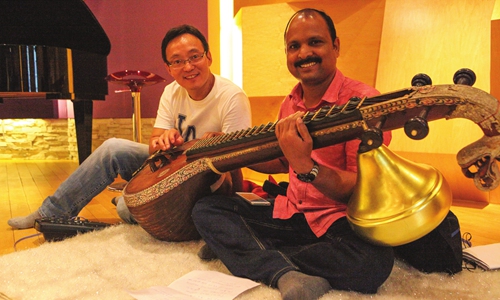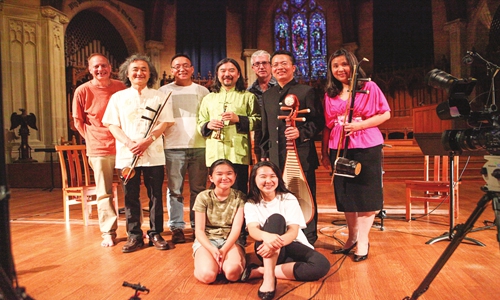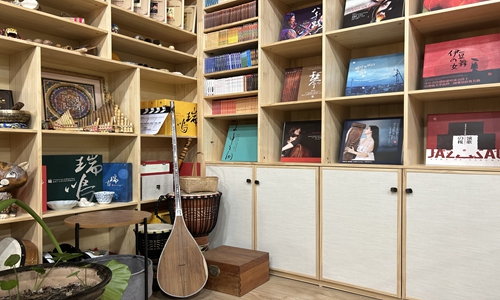
Ye Yunchuan poses for photo with an Indian musician. Photo: Courtesy of Ye Yunchuan
Editor's Note:
How can art and culture from the past survive in a globalized world? Inheriting the treasure of art and culture from the past thousands of years, young Chinese have created a new trend - Guochao, or China chic. It refers to a movement started off by an increasing number of young people who are endeavoring to revive and reinvent on China's traditional culture.
We can see fashion designers drawing inspiration from the precious murals inside the Yungang Grottoes, and traditional instrument players creating all new trendy music on the pipa. These young Guochao trendsetters have helped China's cultural legacies be passed down and preserved for future generations.
In this installment, we look at a Beijing musician who not only chronicles various Chinese folk music from across the country, but also proactively incorporates traditional music with other global genres to create new possibilities in the art scene.
Chinese music producer Ye Yunchuan started the effort to preserve Chinese folk music from across the country more than a decade ago, with the aim of filming and recording all the local music pieces and making them into an archive or library. However, he soon discovered what he believes is a better approach to keeping folk music alive - fusing them with various types of global music genres and instruments.
Strongly influenced by literature, he and his team developed a unique approach to music, infusing folk songs with imaginative and creative elements. This fusion of literature and music has become a defining characteristic of their compositions.
At a music creativity industry park in an eastern suburb of Beijing, Ye's spacious studio exhibits a great variety of vinyl and CD records his company, Rhymoi Music, has produced, as well as the traditional and exotic instruments he has collected. With breath-taking voices singing traditional-sounding opera mixed with exquisite instrumental performances, it gave off an atmosphere of pure musical enjoyment.
Ye said he firmly believes that Chinese music has its own unique qualities and should be celebrated and shared with the world. As he aptly puts it, what he does is to strive to "tell the story of Chinese music in the language of the world."
Archiving folk musicYe has embarked on a self-propelled mission to construct a comprehensive system for Chinese music. He said that despite efforts from both authorities and individual musicians to systematically document Chinese folk music, this vast system has remained fragmented and lacking a unified structure.
Motivated by this realization, the musician began his project aimed at creating a cohesive system province-by-province, county-to-county.
He compared his approach to using a map, stating that it allows for a structured framework that can be continuously expanded upon. Currently, he has only completed the basic structure for 21 out of the 31 provincial regions in the Chinese mainland.
Ye has made available all the finished recordings of the precious grassroots music pieces on popular music apps and the internet at large for the public to enjoy and research, under the name "China Music Map." His immediate goal is to finish establishing all the 31 "pillars" for this project structure, but he also faces the challenge of continuously filling them with content. Given the immense work in itself, he hopes that others, especially young people, will find meaning in the project and contribute to it.
He begins by exploring the music of each region, treating it as an opportunity for discovery.
The musician's ambitious project aims to allow both the Chinese and the world to know about the vast musical heritage of China. With his determination and a systematic approach, he hopes to establish a comprehensive system for Chinese music that will serve as a valuable resource for generations to come.
Turning to music fusionWhen it comes to music, there are two boundaries to consider: fusion and protection. Innovation and protection are two essential aspects of preserving traditional music. True protection, Ye advocates, involves preserving the essence of the music while allowing it to evolve and progress.
Thus he soon embarked on a path of cooperating with various musicians in different countries, experimenting with using Chinese traditional instruments to compose and play together with other nations' instruments.
During a particular fusion project he recently completed in a 500-year-old Japanese temple, the fusion performance featured musicians from China, Japan, South Korea, and Mongolia, each playing their respective traditional instruments.
Instruments such as the
erhu and
guzheng of China, Japanese
shakuhachi,
kayagum from South Korea, and Mongolian morin khuur were all incorporated into the performance.
When musicians from the four countries performed the same composition in the fusion project, such a scene showcased the unity and shared musical language across nations, he said.
The musician praised the philosophical nature of this fusion, emphasizing the need for musicians to reflect on their role in preserving and cherishing the world rather than causing harm.
In another and bolder music endeavor, Ye successfully blended traditional Chinese folk songs with German jazz, creating unique and captivating music. He has released an album that showcases this fusion of cultures and musical styles. The album, which features over 40 musicians, was recorded in Germany, with the entire production, from composition to recording, being handled by German professionals in addition to Ye, who introduced Chinese folk songs to the German jazz scene.
He faced challenges in conveying the essence of Chinese ethnic groups, such as the Tibetans and Mongolians, to the German musicians who were unfamiliar with these cultures. Undeterred, he engaged with them personally, even teaching them traditional ethnic dances to help them understand the emotions and spirit behind the music. For instance, the passionate nature of Tibetan culture, where love can blossom instantly upon two people meeting, was vastly different from the more reserved German approach to relationships, Ye told the Global Times.
The resulting album was humorously referred to by the musician as his own version of Marco Polo's journey.

Ye Yunchuan and other musicians pose for a photo at a Boston church. Photo: Courtesy of Ye Yunchuan
Traditional yet jazzyNot only limited to a "physical" fusion, Ye has also attempted incorporating Western music styles into music played with traditional Chinese instruments.
Back in China, in a groundbreaking musical performance, Ye showcased the fusion of jazz and traditional Chinese instruments, inspired by the spirit of Dunhuang, an ancient city in Gansu Province famous for its thousand-year-old grottoes and Buddhist murals and sculptures. The performance took place at a temple.
Ye explained the role of jazz music in this experiment, emphasizing that it is not about replicating the style of the genre but rather embracing its soul. Seven traditional Chinese instruments played together in improvisation, just like musicians in a jazz band, with no "theme tune" or main player, which is very rare in the traditional Chinese music scene.
The musicians aimed to capture the spirit of Dunhuang's ancient murals and transform it into a contemporary musical expression using Chinese instruments.
By infusing jazz elements into traditional melodies, Ye said this performance successfully conveyed the spirit of Dunhuang while incorporating the improvisational nature of jazz. The result was a unique and captivating performance that showcased the fusion of cultures and the beauty of improvisation in harmony.
This performance gave birth to a brilliant album named
Mingyue Ying Dunhuang, or
The Moon Reflecting Dunhuang.
The artist highlighted the significance of Dunhuang's cultural heritage, emphasizing its role as a melting pot of various influences. The fusion of different cultures and traditions was a key factor in the prosperity of the Tang Dynasty (618-907), when Dunhuang was at its prime time, and Ye aimed to capture this essence through musical exploration.

Ye Yunchuan's music studio Photo: Li Qian/GT
Going viral
Ye takes pride from being dedicated to producing "high-quality music," while he also conceding the importance of adapting to the internet and platforms like TikTok.
He refers to his team as the "Hermès of the music industry," highlighting their preference for understated elegance.
Ye is optimistic about this, saying that while the medium may change, high-quality craftsmanship will always endure, "just like painting did despite the rise of printing."
With such strong belief and confidence in the company's high-quality music production, Ye said his company has embarked on an ambitious project to send a collection of records to 100 prestigious universities worldwide. The project began in November last year, with Harvard University being the first institution to receive a set of record of Ye's selected music. Since then, several other renowned American universities have accepted the collection. Ye's company also donated a collection to the National Library of China.
The collaborations over the years with over 3,000 excellent musicians from more than 20 countries and various ethnicities, including Persians, African-Americans, Latin Americans, Gypsies, Berliners, Indians, and various Chinese ethnic groups, have contributed to the rich tapestry of music that Ye's studio produced.
When the Global Times asked about his ultimate goal, Ye expressed his desire to leave a lasting legacy in the field of art. He compared his work to planting a tree, acknowledging that it may take years for it to grow and flourish. However, he firmly believes in the importance of starting small and nurturing the seedlings, regardless of the time it takes to see results.








